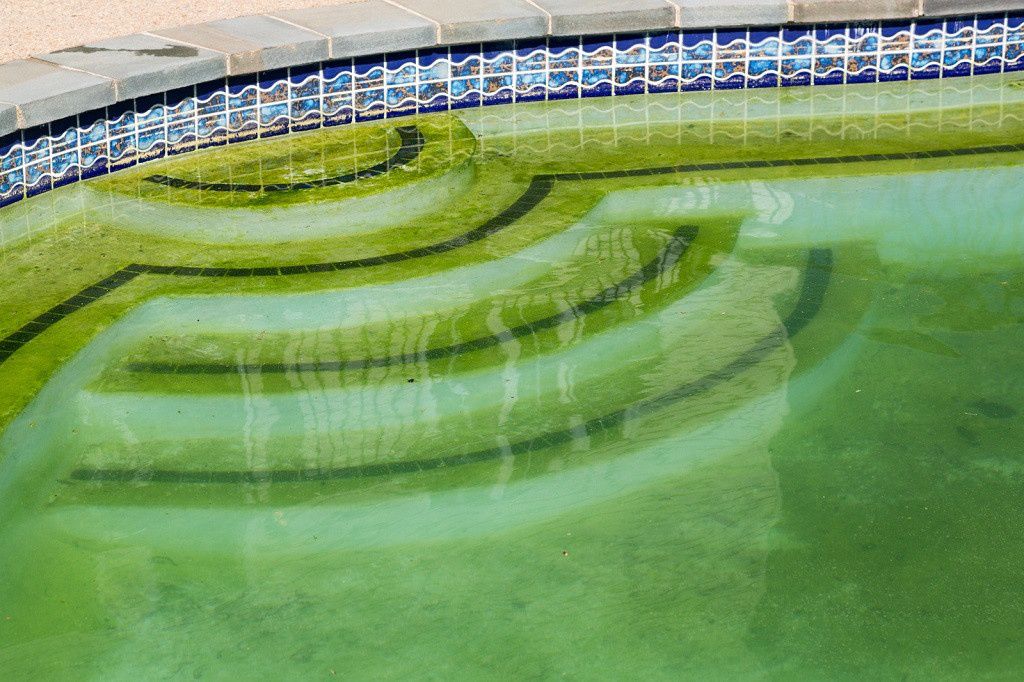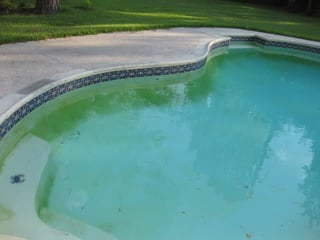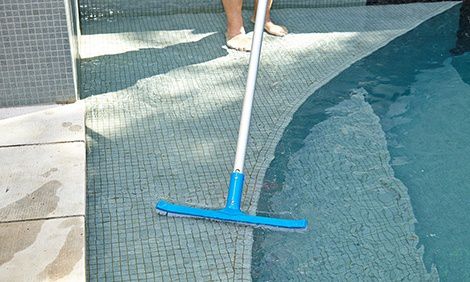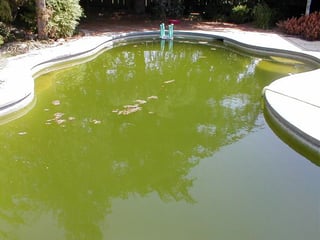
How to Get Rid of Algae in an Inground Swimming Pool
Pool Maintenance | Swimming Pool FAQs
Green: the lovely color of freshly mowed grass, summer leaves fluttering in the breeze, and the protagonist’s eyes in any teen novel in the local library. It’s not so lovely when it’s the color of algae in your inground pool.

Algae can grow in the water, floating freely. It can also cling to the surface of the pool (the sides and bottom), usually in patches.
Most algae is harmless; it’s just ugly and inconvenient. However, the color of the algae will help you determine whether it’ll sting your skin and how much pool shock you’ll need to use to kill it.
(Yep, surprise! While green or blue algae is the most common type, yellow or mustard and black algae can also grow in your pool. You have to shock the living daylights out of black algae.)
What causes pool algae?
As with all maintenance, the best defense is a good offense. Keep up with your regular care, and you’ll have a much lower chance of algae making an unsolicited guest appearance. We recommend salt water chlorine generators for this.
Algae usually grows when chlorine is low and pH is high or low.
Stabilizer provides a buffer so that UV light doesn’t eat up your chlorine. If you don’t have enough stabilizer, then you can dump all the chlorine you want into the water, but it won’t last.
Heads up: the stabilizer is called CYA. This doesn’t stand for what you’re thinking. It means cyanuric acid.
In a salt water pool, these can cause low chlorine levels:
- The salt is low.
- The salt chlorinator system is not functioning correctly.
- The stabilizer is low.
One big way to keep the pool water moving around is to use your pool. What a struggle that will be. Swim to your heart’s content and know that it’s for the benefit of everyone.
Should I drain my pool?
No! Definitely do not drain your pool. If you absolutely feel like you need to, call a professional company first and ask them their opinion and how to do it.
If you drain a vinyl liner pool, you could ruin your liner. For concrete and fiberglass pools, the pool shell could float.
Instead, go through the following steps to kill that garbage.
How to get rid of the algae
Pool people refer to this method as SLAM—Shock, Level, And Maintain. The point is to raise the chlorine/stabilizer extra high and keep it that way until all the algae is dead.
1. Verify your water chemistry is within the ideal range.
Check your test kit for the ideal range for chlorine, pH, and stabilizer.
If your chlorine is low, test your stabilizer levels too.
2. Remedy the chlorine problem.
Add chlorine until it’s at the proper level.
Add stabilizer (if needed) to keep the chlorine at the proper level.
3. Shock/superchlorinate the pool.
Add the shock at dusk or at night so you don’t have to worry about the sun burning off the chlorine.
Wear protective eyewear and gloves.
4. Add algaecide.
Some pool owners choose to only superchlorinate without adding algaecide. If you opt to use algaecide, make sure you use the best type for your situation.
5. Brush the entire pool surface with a pool brush.
(Don’t drain to do this!)
Brush EVERYWHERE, including steps, corners, and ladders.

As the water clears, you may have to repeat this step.
In some cases, you have to vacuum the algae out of the pool. Add flocculant (often called floc) to make the algae coagulate and settle at the bottom of the pool. You can then vacuum up the lumps.
6. Frequently clean the filters.
Monitor the filter pressure. To keep filter media running at optimal pressure, you have to clean it off frequently (possibly every couple hours at first) until all the algae is gone.
If you slack on this step, dead algae will clog up the filters, and you stop making progress.
For a sand filter or a DE (Diatomaceous Earth) filter, you backwash it. For a cartridge filter, you spray it off.
7. Run the pump on high speed nonstop until the water clears.
Do not turn the pump off or let the pool sit for a few hours. If you ease up at all, the rascally algae will bounce right back. Go 24 hours a day, hardcore.
How long will it take to clear the pool?
A fiberglass pool in its worst condition can be algae-free in 24 hours.
For a vinyl liner pool, the process can take 3-4 days.
For a concrete pool, this can take a week or more.
How much does it cost?
A good bottle of algaecide is usually about $30.
A 1-pound bag of shock is $3-$5, and you’ll probably use 1-3 pounds, so $3-$15.
The energy cost of running the pump/filter system is negligible.
Other causes of green water
If the green-water issue isn’t algae, you may have copper or iron in the water. To remedy this, add a metal sequestering agent.

After algae shows up once, it’s likely to show up again. Keep a close eye on your pool in case you need to SLAM it again. (That acronym feels so aggressive. For maximum effect, you can scowl and slap your hand on a table or wall while you say “SLAM.”)
How the pool types compare
Concrete pools are the most prone to algae because they’re super porous. Vinyl liners are less porous and therefore less prone to algae, although it can still grow in cracks and seams where water doesn’t circulate well.
By comparison, the surface of a fiberglass pool is relatively nonporous and algae-resistant. If you or your hospitable neighbor is buying a pool, keep in mind that fiberglass pools have fewer problems with algae.
You can read this comparison of the three pool types and download our ebook on how the three pool types stack up for even deeper detail.
If you would like to speak with a pool company to see if a fiberglass pool is right for you, contact us. We'd love to put you in touch with an independent installer near you!
Up Next:
Swimming Pool Sanitizers: The 7 Best Options to Consider (Pros/Cons)
How to Keep Your Pool Water Clean and Prevent Pool Parasites
Chlorine vs Bromine: Which is Better?
Editor's note: This article was updated on November 14, 2023.




